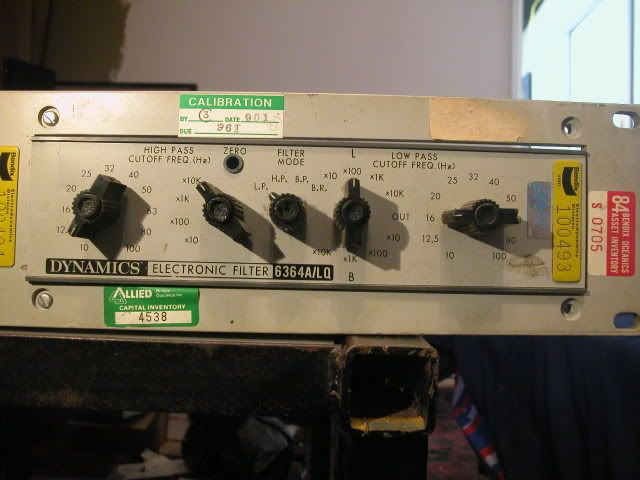I've been getting s slew of used gear in recently.
Here I have a dual electronic filter by Dynamics Electronics Products Inc. (Chatsworth, CA)....model 6364A/LQ

more pics:
http://i5.photobucket.com/albums/y177/Midiot/DSCN2337.jpg
http://i5.photobucket.com/albums/y177/Midiot/DSCN2334.jpg
I am hoping it might be swell for audio use...EQ.
What is the best way to test it?
I don't have a hardware spectrum analyzer.
But I DO have software versions....my RME soundcard comes with a Spectral Analyser (DigiCheck), and Wavelab has one too, an FFT version.
I don't know yet if the filter's output needs attenuation.
What is the ideal signal to put through this filter?
I have some files on the 'puter ...
Pink Noise,
UNcorrelated Pink (20 dBFS)
Multi-tone with 1kHZ spacing
Multi-tone w/ 500 kHZ spacing
Blue, White, Brown, Violet noises,
and of course an outboard funct. gen.
Thanks,
=FB=
(Dynamics was bought by Bendix/Allied in the early 80's I believe, and this unit is from the late 70's)
Here I have a dual electronic filter by Dynamics Electronics Products Inc. (Chatsworth, CA)....model 6364A/LQ

more pics:
http://i5.photobucket.com/albums/y177/Midiot/DSCN2337.jpg
http://i5.photobucket.com/albums/y177/Midiot/DSCN2334.jpg
I am hoping it might be swell for audio use...EQ.
What is the best way to test it?
I don't have a hardware spectrum analyzer.
But I DO have software versions....my RME soundcard comes with a Spectral Analyser (DigiCheck), and Wavelab has one too, an FFT version.
I don't know yet if the filter's output needs attenuation.
What is the ideal signal to put through this filter?
I have some files on the 'puter ...
Pink Noise,
UNcorrelated Pink (20 dBFS)
Multi-tone with 1kHZ spacing
Multi-tone w/ 500 kHZ spacing
Blue, White, Brown, Violet noises,
and of course an outboard funct. gen.
Thanks,
=FB=
(Dynamics was bought by Bendix/Allied in the early 80's I believe, and this unit is from the late 70's)


































